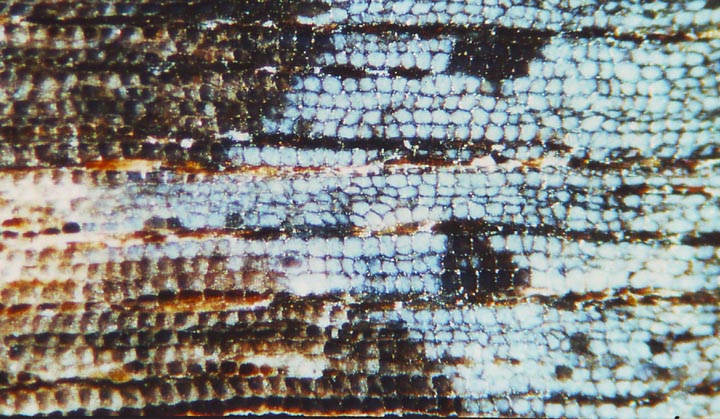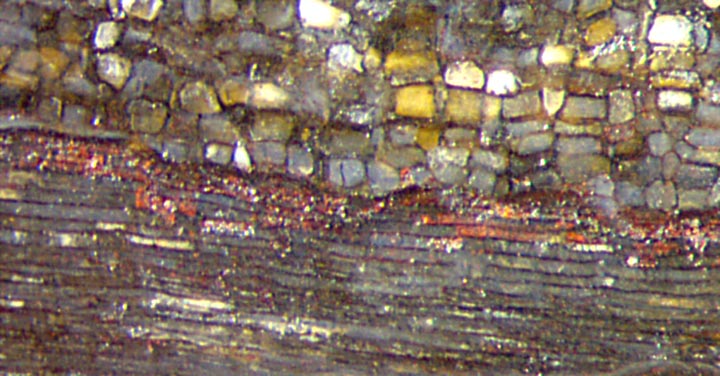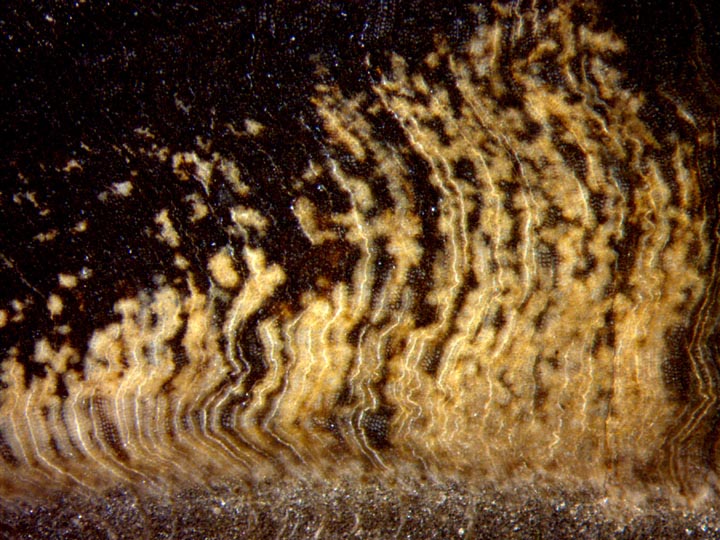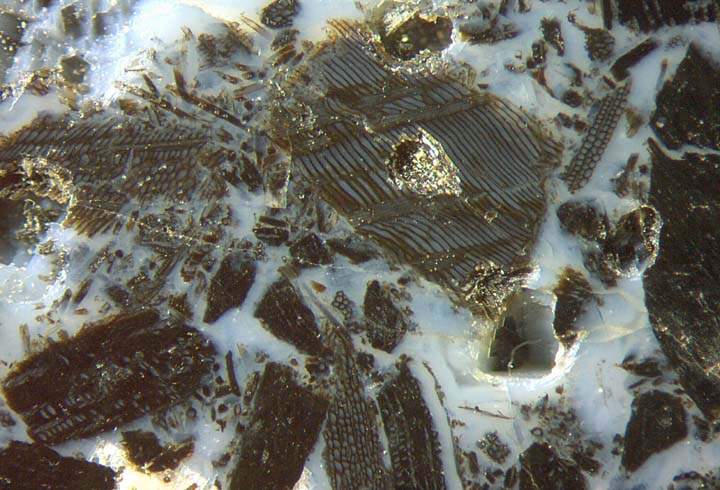Beautiful Permian wood from Döhlen
Basin
Wood from Permian conifers, summarily named Dadoxylon for
simplicity, is usually less interesting to fossil collectors since
most often it
does not show distinct features like the central pith or wide pith
rays. Despite of the usually dull aspect, the
interest may be aroused by secondary phenomena related to degradation
and silicification, which may result in beautiful pictures.


Fig.2: Wood
cut lengthwise with central pith above. [ 1 ]
Fig.1: Cross-section, cells with chalzedony fills: bluish white, black, or clear with shadows in the depth
(left). Figs.1,2: same scale, widths
2mm.
The aspect of the chalzedony seems to
be very sensitve to tiny differences in the chemical composition of the
compartment. Hence, the fill of neighbouring cells may be clear, white,
or black as in Fig.1 or variously coloured as in Fig.2.


Fig.4: Cells with yellow stained chalzedony,
recrystallized as white spots
with rare "daisy aspect". Picture width 5mm.
Fig.3: Wood
well silicified except for the hole in every cell: unexplained
rare phenomenon. Picture width 4mm.


Fig.6: Wood
disintegrated while soft, then silicified: no charcoal.
Width 5mm.
Fig.5: Wood with small cells,
deformed, partially bleached. Width 5.5mm.
Arguably,
Fig.5 may be considered the most beautiful of these pictures. The
flame-like aspect is due to bleaching along the radial wood rays and to
slight radial compression which caused the rays to kink irregularly.
The bleaching by carbon oxidation was possibly caused by oxygen diffusion along the rays. This wood
differs from the others by narrower cells, hard to see here as tiny
dots in
some places, better seen with the same sample in [ 2 ].
Finally, Fig.6 may be
considered the most controversial of these pictures. This sample from the Wilmsdorf golf course has provided essential arguments so that prominent palaeobotanists (M. Barthel, Berlin, and R. Roessler,
Chemnitz) had to admit that they
were wrong with their favourite interpretation of black Permian wood as
fossil charcoal [3-5]. Looking carefully reveals that the wood was soft
while disintegrating:
See [ 6 , 7 ].
Additional evidence contradicting the charcoal
interpretation is offered by the smallest parts in Fig.6. Crushed
charcoal would never yield tube-like fragments representing
individual cells. These details indicate that the tissue had lost its
coherence, apparently by prolonged submersion, so that the wood could
easily disintgrate, producing fragments of any size and shape, among
them separate cells.
Unrelated to the above problem but worth mentioning are several
cavities in the polished face of Fig.6. They are due to dissolved calcite
crystals which had grown in the wood or in plain chalzedony. One not
yet dissolved white calcite crystal is seen below.
Samples: from Döhlen Basin near Dresden, Saxony; kept in
the own collection.
Fig.1: Kc/14.1, found by
Andrea
Weiss at Kleincarsdorf in 1997;
Figs.2-6: W/42.1, W/48.1,
W/95.1,
W/35.1,
W/55.3,
found
during the preparation of the golf area at Wilmsdorf in the
early 90s;
H.-J.
Weiss 2019
[1] www.chertnews.de, Fossil
Wood News 31
[2] www.chertnews.de, Fossil
Wood News 33
[3]
R.
Noll, D. Uhl, S. Lausberg : Brandstrukturen an
Kieselhölzern der Donnersberg Formation.
Veröff. Mus. Naturkunde Chemnitz 26
(2003), 63-72.
[4] R.
Rössler : Der versteinerte Wald von Chemnitz. Museum f.
Naturkunde Chemnitz, 2001, 179.
[5] R.
Noll, V. Wilde : Conifers from the „Uplands“ –
Petrified wood from Central Germany,
in: U. Dernbach, W.D. Tidwell :
Secrets of Petrified Plants, D'ORO Publ., 2002, 88-103
[6] www.chertnews.de, Fossil
Wood News 9
[7] www.chertnews.de, Fossil
Wood News 35
|

|
 34 34 |

 34
34






 34
34